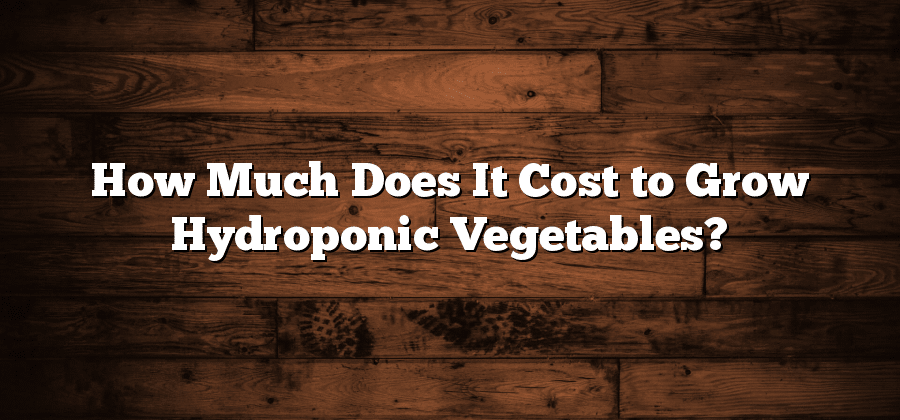Understanding the Initial Investment Required
When starting a hydroponic system, it is crucial to understand the initial investment required. This includes the expenses for purchasing the necessary equipment and setting up the infrastructure. While the costs may vary depending on the scale of the operation and the specific requirements, there are certain core components that every hydroponic system needs.
First and foremost, a hydroponic system requires a grow space. This can range from a small area in a backyard greenhouse to a large commercial facility. The cost of acquiring or constructing the grow space can be significant, as it needs to provide ample room for the plants, lighting, and other equipment. Additionally, factors such as insulation, temperature control, and ventilation should be taken into account to ensure optimal growing conditions. Therefore, it is essential to carefully consider the size and specifications of the grow space while planning the initial investment.
Calculating the Expenses for Hydroponic Equipment
When it comes to getting started with hydroponics, one of the first considerations to take into account is the expense of the necessary equipment. The initial investment required for setting up a hydroponic system can vary greatly depending on the scale and complexity of the setup. From basic setups for home gardening to commercial-grade systems for large-scale production, the cost of equipment can range from a few hundred dollars to several thousand.
To calculate the expenses for hydroponic equipment, it is important to make a list of all the components needed. These components may include grow lights, reservoirs, growing containers, pumps, timers, air stones, and ventilation systems. Additionally, considering factors such as the size of the desired system, the type of plants to be grown, and the level of automation required will help determine the specific equipment needed and its associated costs. It is essential to thoroughly research and compare prices from various suppliers to ensure the best combination of quality and affordability.
Evaluating the Cost of Nutrient Solutions
Nutrient solutions play a crucial role in hydroponic systems as they provide the essential elements needed for plant growth. Evaluating the cost of nutrient solutions is an important aspect to consider when starting a hydroponic operation. The expense of nutrient solutions can vary depending on the type and brand, as well as the size of the hydroponic system.
When calculating the cost of nutrient solutions, it is important to consider the specific needs of the plants being grown. Different crops may require different nutrient formulations, and it is essential to provide the right balance of macro and micronutrients for optimal growth. Additionally, it is important to factor in the cost of replenishing and replenishing the nutrient solution over time, as it can become depleted as plants absorb the nutrients. This ongoing expense needs to be considered in the overall budget for operating a hydroponic system.
Analyzing the Energy Costs for Hydroponic Systems
The energy costs associated with hydroponic systems can vary depending on the specific setup and equipment used. These costs are an essential aspect to consider when evaluating the overall expenses of running a hydroponic operation.
One significant factor that affects energy costs is the type of lighting used. Traditional high-intensity discharge (HID) lights, such as metal halide and high-pressure sodium lamps, can consume a substantial amount of electricity. However, advancements in LED lighting technology have enabled growers to reduce energy consumption significantly. LED lights not only consume less electricity but also produce less heat, which can help maintain a more consistent temperature in the growing environment. This not only saves on energy costs but also reduces the need for additional cooling equipment, further lowering expenses.
Another aspect to consider when analyzing energy costs is the overall power usage of the system. Hydroponic systems typically require pumps, fans, and timers to function properly. These components can contribute to electricity consumption, albeit in smaller amounts compared to lighting. It is essential to estimate the power usage of each component and calculate the cost based on the local electricity rates to get an accurate assessment of the energy expenses involved in running a hydroponic system.
While energy costs can be a substantial factor in the overall expenses of hydroponic systems, making informed choices about lighting and power usage can help reduce these costs. By investing in energy-efficient equipment and optimizing the system’s usage, growers can strive for a more sustainable and cost-effective approach to hydroponic cultivation.
Estimating the Expense of Growing Mediums
When it comes to estimating the expense of growing mediums in hydroponic systems, there are several factors to consider. The choice of growing medium can greatly impact not only the cost but also the overall success of your hydroponic operation. The most commonly used growing mediums include rockwool, coconut coir, perlite, and clay pebbles. Each of these mediums has its own pros and cons in terms of water retention, aeration, and nutrient absorption.
The expense of growing mediums can vary significantly depending on the scale of your hydroponic operation and the type of medium chosen. For smaller-scale operations or hobbyists, the cost may be relatively low. However, for larger commercial setups, the expense can add up quickly. It is important to weigh the cost against the benefits to ensure that you are choosing the most cost-effective option without compromising the quality and yield of your hydroponically grown crops.






